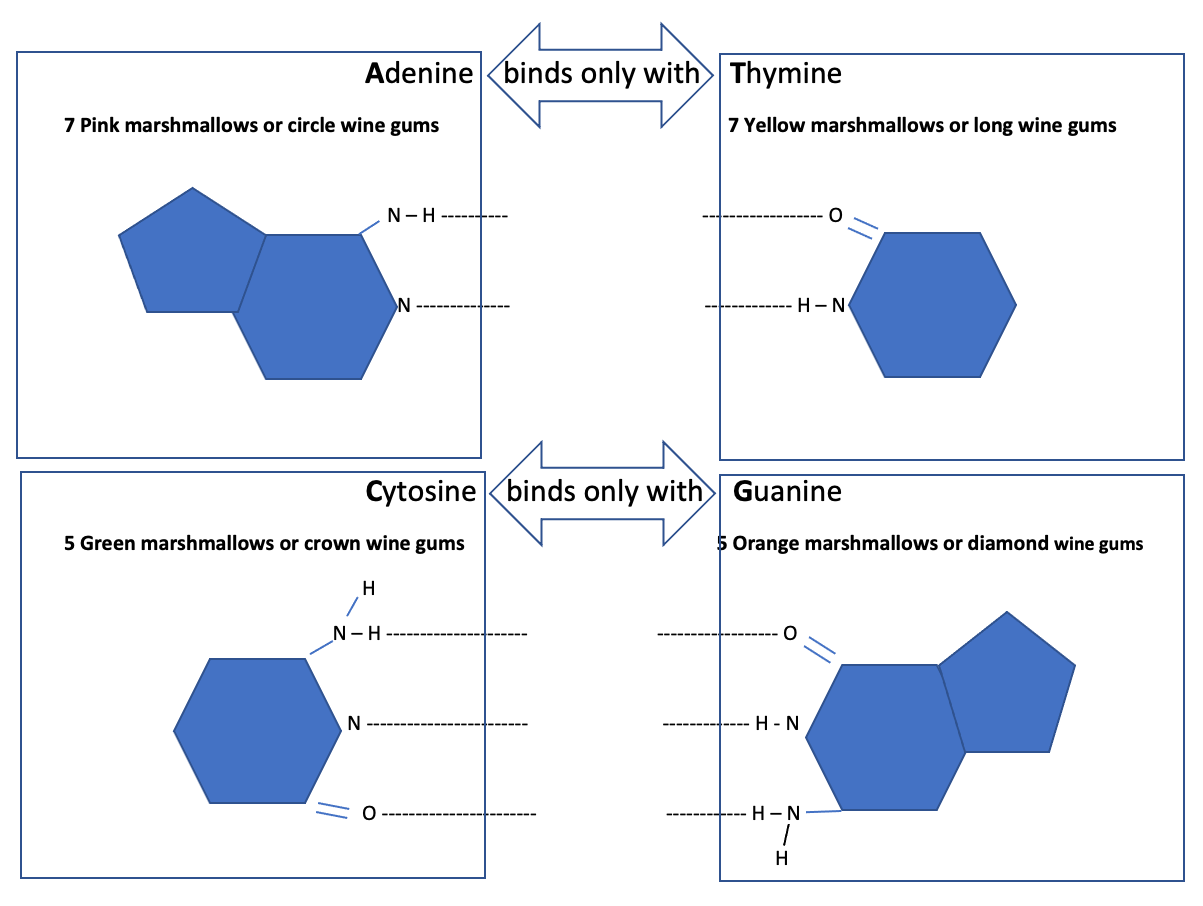Making Candy DNA
Deoxyribonucleic Acid (DNA) stores the genetic code in the nucleus of eukaryotic cells. The DNA double helix structure is composed of: a backbone of ribose sugar and phosphate; and the base pairs that are like the rungs of a ladder. The backbone is held together by phosphodiester bonds between the sugars and phosphates. The base pairs are made up of complementary nitrogenous bases. The nitrogenous bases are Adenine, Guanine, Thymine and Cytosine. Adenine will only bind with Thymine (Apples in a Tree) and Cytosine will only bind with Guanine (Car in the Garage). These nitrogenous bases are held together by hydrogen bonds. DNA can be replicated in the nucleus or transcribed into Messenger Ribonucleic Acid (mRNA) which is then translated into proteins.
DNA is transcribed into mRNA, which leaves the nucleus to the ribosome, where the mRNA is used to make proteins encoded in the mRNA. At the ribosome the mRNA is translated by matching the coded amino acids (AA) to build the protein. Amino acids are held together by peptide bonds to form the protein. Enzymes are also a type of protein.
Materials:
- 2 long strands of licorice (sugar-phosphate backbone)
- 12 toothpicks
- 7 pink marshmallows or 7 circle shaped wine gums (adenine)
- 7 yellow marshmallows or 7 long shaped wine gums (thymine)
- 5 green marshmallows or 5 crown shaped wine gums (cytosine)
- 5 orange marshmallows or 5 diamond shaped wine gums (guanine)
- 1 Candy DNA Worksheet
Candy DNA Worksheet
Click here to download the Candy DNA worksheet
Please note: the worksheet information is presented below as well.
Starting DNA strand: CAACTGTGAAGA

Methods:
- Sort your shaped wine gums or coloured marshmallows on the Worksheet. Adenine is pink mini marshmallows or circle wine gums; Thymine is yellow mini marshmallows or long wine gums; Cytosine is green mini marshmallows or crown shaped wine gums; and Guanine is orange mini marshmallows or diamond shaped wine gums.
- Start with the first base at the left on the DNA strand shown on the Worksheet. “C” equals Cytosine which is the green or crown shape candy base, stick the coloured or shaped candy base into one of the toothpick ends and a bit through.
- Push the candy base onto the toothpick end leaving room to stick the same toothpick end into one long strand of licorice backbone.
- Continue adding candy base to the single strand of licorice backbone by sticking the candy onto the toothpick and the toothpick into the long licorice, with the bases listed on the Worksheet. A for Adenine, A for Adenine, C for Cytosine, T for Thymine, G for Guanine, T for Thymine, G for Guanine, A for Adenine, A for Adenine, G for Guanine, and finally A for Adenine.
- With half of the DNA strand complete, you can start matching to create the base pairs.
- Find the matching candy base and push the candy into the open end of the toothpick to be beside the existing candy base to make the base pair. Remember that adenine always and only binds with thymine and cytosine always and only binds with guanine.
- Once the base pairs are on the toothpicks, you can add the second strand of long licorice to the open ends of the toothpicks to add the second sugar-phosphate backbone.
- Give the DNA ladder a twist counter-clockwise from the top to create the double helix.
Finished DNA double strand:
| CAA | CTG | TGA | AGA | ||
| GTT | GAC | ACT | TCT | transcribed from DNA to mRNA | |
| Amino Acids: | Val | Asp | Thr | Ser | translated from mRNA to AAs |
A small portion of the DNA sequence coding for yeast ADHII (yeast alcohol dehydrogenase 2). The DNA coding the protein (enzyme) is 1046 base pairs in length.
The yeast alcohol dehydrogenase 2 enzyme is used in anaerobic (no oxygen) fermentation of glucose (sugar) to the products of ethanol and carbon dioxide.
C6H12O6 → Alcohol dehydrogenase → 2 C2H5OH + 2 CO2
This process is used in baking bread (CO2 gas causes the bread to rise, ethanol is cooked off) and making wine and beer (CO2 gas is released from the container, ethanol is left to make the beverage).
Can you think of other products we use or eat that are made from alcoholic fermentation?
The candy that you have used to make the DNA, where does that come from?
I look forward to talking with you about your Candy DNA experience during the live sessions.
References:
Madigan, M.T., Bender, K.S., Buckley, D.H., Sattley, W.M., and Stahl, D.A. (2021). Brock Biology of Microorganisms. 16th Edition. Hoboken, NJ: Pearson Education. pp. 166 – 192.
Moore, D., Robson, G.D., and Trinci, A.P.J. (2011) 21st Century Guidebook to Fungi. Cambridge, UK: Cambridge University Press. pp. 475 – 477.
Russell, D. W., Smith, M., Williamson, V.M., and Young, E. T. (1983) Nucleotide sequence of the Yeast Alcohol Dehydrogenase II Gene. The Journal of Biological Chemistry. Vol 258, No. 4, pp. 2674 – 2682.